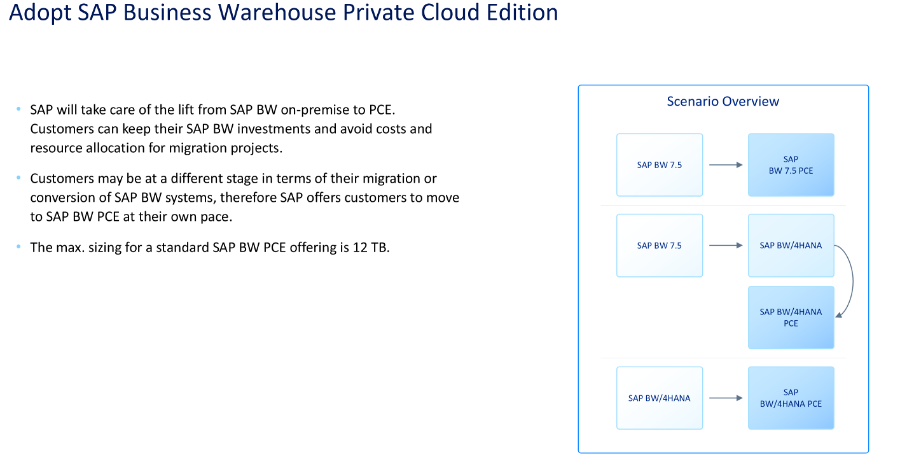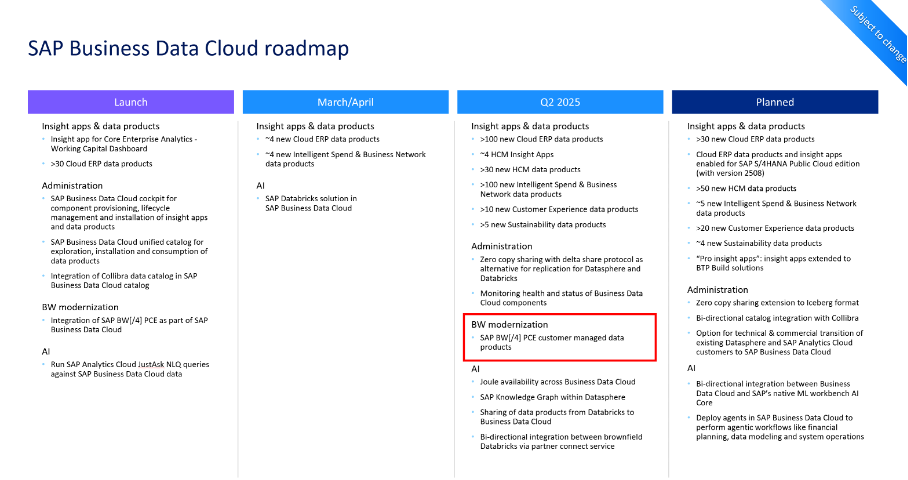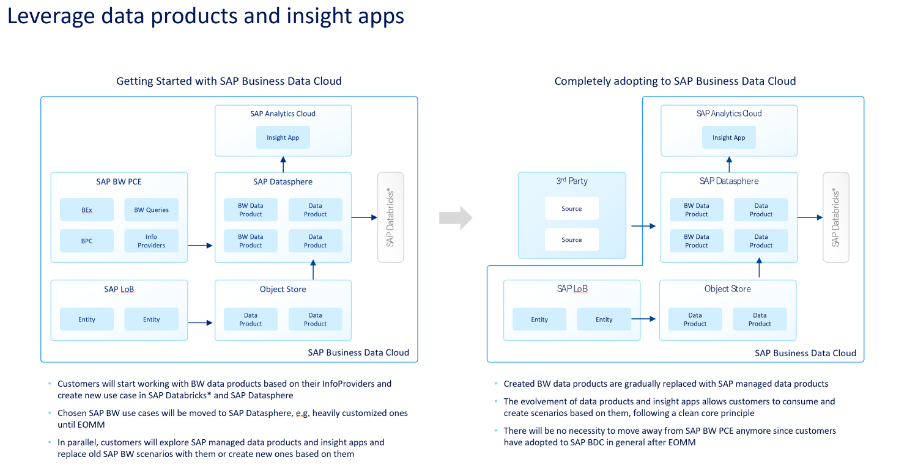
SAP BW 7.5 PCE in Business Data Cloud – The legacy objects Dilemma
SAP BW 7.5 on PCE (Private Cloud Edition) has been positioned as a bridge (sounds familiair?) between classic on-premise BW and SAP Datasphere. Simply put: move your existing BW 7.5 system to the cloud as-is and you can use it as a source for Business Data Cloud (via so called data products).
The BW 7.5 end of life is set to (in stone) to 2030, while BW/4 is positioned “beyond 2030“. In practice, most likely 2040.
However, when it comes to integrating SAP BW into the Business Data Cloud (BDC), a couple of major pain points remains:
- What are we going to do with our BW 7.5 system beyond 2030?
- How are we going to migrate our non BW/4 compliant objects after 2030?
This raises crucial questions about the longevity of SAP BW 7.5 PCE , its role in a modern cloud data strategy, and the necessary workarounds to maintain business continuity.
The Reality Check: BW Extraction Context in Business Data Cloud
SAP’s Business Data Cloud (BDC) is positioned to be the strategic backbone for enterprise data management, promising a seamless connection between SAP and non-SAP data sources.
Currently BW 7.5 systems can already be connected to Datasphere and the BW objects can be used as a basis for further modelling (let’s call them into data products).
The BW Extraction Context currently offers access to InfoProviders, supporting:
- DataStore Objects (classic and advanced), ODSO and ADSO
- CompositeProviders (HCP)
- Queries as InfoProviders (with some OLAP limitations)
- InfoObjects (characteristics)
- Cubes and MultiProviders
Basically everything which is supported via the good old ODP framework
While this is truly great, the elephant in the room is the legacy object conversion gap.
What’s the Issue?
Not All Objects from BW 7.5 are present in BW/4HANA PCE
Many traditional SAP BW 7.5 objects, such as classic InfoCubes, MultiProviders, and older (3.x, believe me, these objects are still around) at present cannot be used in BW/4HANA PCE and therefore will not be able to be used in BDC after 2030.
While BW Queries can be used as InfoProviders, their OLAP capabilities are restricted. This means businesses relying on queries as a source for modelling, will face challenges.
So why would they be in Business Data Cloud?
Moving to BW 7.5 PCE sounds like a great quick win, but what about 2030?
Organizations using BW 7.5 PCE will need to convert to CompositeProviders and Advanced DSOs (aDSO) and to BW/4HANA PCE.
Ofcourse you could rebuild everything in Datasphere, but why didn’t you do that in the first place? Exactly: technical depth and lack of time.
In short, move to BW/4HANA PCE instead of BW 7.5 because if you don’t, you will face an ENORMOUS issue beyond 2030
Unfortunately, I still come across many systems where classical objects are still heavily used (e.g. in Planning, as a basis for reads in transformations or simply as reporting items). It has been an issue for over a decade, lifting and shifting an ancient BW system will not improve when putting it in BDC.
Below picture neatly shows BPC, BW Queries and BEx objects transferred into Datasphere BW Data Products, it however does not show the how…
What Are the options?
Given these limitations, I believe organizations still need a structured approach to migration:
- Convert Old BW (3.x and 7.x) Objects to BW/4HANA-Compatible Formats
- Move from MultiProviders → CompositeProviders
- Convert classic DSOs → Advanced DSOs (aDSOs)
- Phase out old InfoCubes in favor of Advanced DSOs (aDSOs)
There is some great 3rd party tooling to do this. More on this in a later blog!
- Use Hybrid Architectures to Bridge the Gap
- For businesses not yet ready to move entirely to Business Data Cloud, hybrid architectures can help: Keep SAP BW BW/4HANA PCE only as a data staging layer (based on aDSOs) and do reporting either in Datasphere or Databricks
- Migrate to BW/4HANA on prem and use BW/4HANA PCE
- This might be feasible if BW is already in a pretty good shape (on new objects) and BDC licensing does not cost you an arm and a leg.
- Kill your BW system and start from scratch in BDC
- If the majority of your system is based on legacy objects, this is the way to go.

Interdobs BW Bridge Optimizer
One tool that can help organizations assess the complexity and effort of moving to modern SAP BW/4HANA objects is the Interdobs BW Bridge Optimizer. This solution scans existing BW systems to:
- Identify legacy BW objects and dependencies
- Determine which objects can be converted into BW/4HANA-compatible structures (like aDSOs and CompositeProviders)
- Provide an impact analysis and recommended actions to simplify and streamline conversion
By using the BW Bridge Optimizer, businesses can gain immediate visibility into the scope and scale of their BW environment. Armed with this insight, they can make informed decisions about how, when, and in what sequence to tackle migrations—thereby minimizing project risk and reducing system downtime.
Final Thoughts: SAP BW 7.5 PCE – A Temporary Fix or Long-Term Strategy?
SAP BW 7.5 PCE offers businesses a middle ground between traditional BW and a full migration to Business Data Cloud. Giving many organizations finally a fighting chance to modernize their BW stack into the Cloud.
However, its partial compatibility with Business Data Cloud beyond 2030 means organizations must invest in object conversion and restructuring to avoid future roadblocks. Even though this might be an open door, I’m guessing that notion might be a bit buried under the Marketing messaging.
As SAP continues to evolve its cloud-centric data strategy, businesses still heavily reliant on legacy BW objects should question whether investing in BW 7.5 PCE aligns with their long-term strategy, or if a direct migration to SAP DataSphere (or BDC) is more appropriate .
The challenge is clear: SAP BW 7.5 PCE is not a future-proof solution without active planning for a full transition to modern SAP data architectures. It either being BDC or BW/4HANA or BW/4HANA PCE.
If you remember one thing from this blog, it should be this: optimize your BW system, where ever you are in your Cloud transition!



